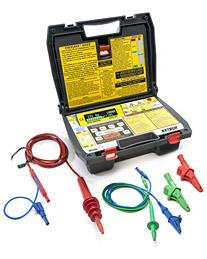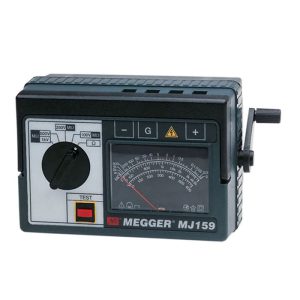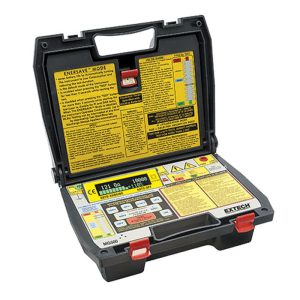Are you seeking for a tool to measure the resistance of systems and materials used for electrical insulation that is trustworthy and accurate? Are you interested in learning how to select the ideal insulation resistance tester for your requirements and price range? In that case, you’ve found the right location.
This article will define an insulation resistance tester, discuss its significance, and describe how it operates. The best qualities and differences of three insulation resistance testers from the website mme-ae.com will also be compared. You will know more about insulation resistance testing and how to pick the right product for your application by the time you finish reading this article.
What are the top options for features and goods if you’re looking for an insulation resistance tester? The ability of electrical insulation materials and systems to resist the flow of electric current can be measured using an insulation resistance tester, also referred to as a megger tester or a high voltage tester.
This can assist you in evaluating the insulation’s quality and condition and help you avoid dangers like electric shocks, fires, and equipment damage.
Three insulation resistance testers from the website mme-ae.com will be compared in this article, with an emphasis on their top qualities and key distinctions. Which are:
Major Megger Insulation Testers MJ159-MJ359 and 210170 from MEGGER
Testing insulation using the EXTECH MG500
Testing high voltage insulation using the Kyoritsu KEW 3127
The MEGGER MJ159-MJ359 and 210170 Major Megger Insulation Testers will be discussed first.
These analog testers that must be manually cranked may measure insulation resistance up to 2000 M at 1000 V. They have a straightforward meter that is simple to read and displays the resistance value directly.
Additionally, they feature a variety of test voltages for spot and step voltage testing, which can assist you in finding flaws and deterioration that digital testers might not be able to reveal.
Additionally, they contain a guard terminal to remove surface leakage current, which can compromise the measurement’s accuracy.
These testers are perfect for inspecting outdated or broken insulation systems, such as those found in manufacturing facilities, power plants, or historic structures.
They are useful for outdoor operations and distant places because they are simple to use and run without batteries. However, they might not be able to do complex diagnostics or measure very high resistance values like digital testers can.
The EXTECH MG500 Insulation Tester is the next item. This digital tester has a measurement range of 500 G at 10 kV for insulation resistance.
It contains high test voltages that can be used to test transformers, generators, and switchgear, as well as high voltage equipment and cables.
Additionally, it offers sophisticated characteristics like polarization index (PI) and dielectric absorption ratio (DAR) measurements that can reveal the caliber and state of the insulation.
In contrast to DAR, which is the ratio of the resistance after 60 seconds to the resistance after 15 seconds of testing, PI measures the resistance after 10 minutes compared to the resistance after 1 minute of testing. Better insulation quality is indicated by higher PI and DAR values.
The ability of this tester to deliver precise and dependable measurements of insulation resistance makes it ideal for evaluating high voltage machinery and cables. In order to conserve energy and lengthen battery life, it also contains an EnerSaveTM feature that restricts test duration to 10 seconds.
It also includes batteries, test leads, alligator clips, and a heavy-duty carrying case with a cover built right in.
Additionally, it contains a sizable backlit LCD display that can simultaneously display time, capacitance, leakage current, and voltage.
It might not, however, be able to test low voltage apparatus or deliver more thorough diagnostics than other digital testers can.
The Kyoritsu KEW 3127 High Voltage Insulation Tester is our last option. This digital tester has a maximum measurement range of 35 T at 5000 V for insulation resistance. It can test many kinds of insulating materials and systems because of its wide range of test voltages, which vary from 250 V to 5000 V.
Additionally, it features thorough diagnostic tools such the polarization index (PI) test, step voltage test, dielectric discharge (DD) test, and ramp test. The test voltage is raised gradually throughout the ramp test until a breakdown takes place or a predetermined limit is reached.
Step voltage testing involves applying various test voltages incrementally while measuring resistance. After the test voltage is switched off, the discharge current is measured during the DD test. The polarization index is measured via the PI test, as previously mentioned.
Because it can provide a wide range of test voltages and diagnostics, this tester is perfect for testing different kinds of insulation materials and systems. A sizable LCD monitor with a backlight and a timer feature is also included.
Additionally, it has a 5 mA short circuit current, which can produce measurements that are more precise than those with smaller currents. It might not be as user-friendly or durable as other testers, though.
Table of Contents
ToggleHere is a list of their characteristics and variations:
The MEGGER MJ159-MJ359 and 210170 Major Megger Insulation Testers1 contain a guard terminal to prevent surface leakage current, several test voltages for spot and step voltage testing, and no scale multipliers. They are analog hand-cranked testers with a maximum measurement range of 2000 M at 1000 V for insulation resistance.
The EXTECH MG500 Insulation Tester2 features a built-in heavy duty carrying case with cover, test leads, alligator clips, and batteries, high test voltages up to 10 kV with insulation resistance to 500 G, polarization index (PI) measurement, dielectric absorption ratio (DAR) measurement, EnerSaveTM feature that limits test duration to 10 seconds to save energy, and more. It is a digital tester that can show time, capacitance, leakage current, and voltage all at once.
A short circuit current of 5 mA, a test voltage range of 250 V to 5000 V, and advanced diagnostics like ramp test, step voltage test, dielectric discharge (DD) test, and polarization index (PI) test are all features of the Kyoritsu KEW 3127 High Voltage Insulation Tester3.
A sizable LCD monitor with a backlight and a timer feature is also included. It is a digital tester that has a 35 T maximum measurement range for insulating resistance.
The MEGGER MJ159-MJ359 and 210170 Major Megger Insulation Testers are described as follows:
These testers contain a rotary switch that allows you to choose between a test voltage range of 100 V and 1000 V. For testing and measuring voltage, they also feature a voltage range of 0 V to 600 V.
The huge analog meter on these devices has four scales: 0-200 M, 0-20 M, 0-2 M, and 0-200 k. The meter contains a zero adjust knob to calibrate the meter before testing and a mirror scale to lessen parallax inaccuracy.
The test voltage and power are provided by a hand-cranked generator in these testers. When the desired test voltage is obtained, a mechanical brake on the generator causes the crank to halt. Additionally, the generator incorporates an overload safeguard that guards against harm to the tester or the insulation being tested.
To remove surface leakage current from the measurement, these testers contain a guard terminal that can be linked to a third lead. This can increase the measurement’s precision and dependability, particularly for surfaces with high insulating resistance or that are moist or unclean.
These testers are built tough and solidly to resist challenging environments and hard handling. For simple carrying and storage, they include a metal case with a leather handle and strap. Additionally, they have a waterproof top that shields the controls and meter from dirt and moisture.
An instrument that measures the resistance of electrical insulation materials and systems is known as an insulation resistance tester. This can assist you in evaluating the insulation’s quality and condition and help you avoid dangers like electric shocks, fires, and equipment damage.
Insulation resistance testers come in a variety of varieties, each with unique features and benefits. The greatest qualities and differences of three insulation resistance testers from the website mme-ae.com are contrasted and highlighted in this article.
Which are:
The hand-cranked analog insulation testers MEGGER MJ159-MJ359 and 210170 Major Megger are capable of measuring insulation resistance up to 2000 M at 1000 V. As they can find defects and deterioration that digital testers might not be able to see, they are perfect for testing outdated or damaged insulation systems.
They are useful for outdoor operations and distant places because they are simple to use and run without batteries.
A digital tester called the EXTECH MG500 Insulation Tester can measure insulation resistance up to 500 G at 10 kV. It contains high test voltages that can be used to test transformers, generators, and switchgear, as well as high voltage equipment and cables.
Additionally, it offers sophisticated characteristics like polarization index (PI) and dielectric absorption ratio (DAR) measurements that can reveal the caliber and state of the insulation. Additionally, it boasts a tough design and a case that protects it from severe situations.
A digital tester called the Kyoritsu KEW 3127 High Voltage Insulation Tester can measure insulation resistance up to 35 T at 5000 V.
It can test many kinds of insulating materials and systems because of its wide range of test voltages, which vary from 250 V to 5000 V. In-depth diagnostics like the ramp test, step voltage test, dielectric discharge (DD) test, and polarization index (PI) test are also included, and these tests can provide you more details about how well the insulation is performing.
It also boasts a sizable, crystal-clear display that can simultaneously display several metrics and graphs.
We trust that this post has given you a better understanding of the characteristics and variations among these three insulation resistance testers from mme-ae.com.
Please visit their website or get in touch with their customer service if you are interested in purchasing any of these products or would like more information about them. Happy testing, and thanks for reading.
Visit their website to look over their selection of insulation resistance testers if you’d want to make a purchase suggestion.
If you’d like to learn more about the three goods we’ve compared in this post,
you can also click on the links below:
Major Megger Insulation Testers MJ159-MJ359 and 210170 from MEGGER
Testing insulation using the EXTECH MG500
Testing high voltage insulation using the Kyoritsu KEW 3127
As an alternative, you can get in touch with their customer support by phone or email and request their knowledgeable counsel and suggestions. They will be pleased to help you and respond to any inquiries you may have on their goods and services.




